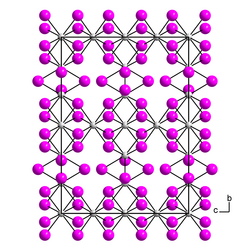 | |
| Identifiers | |
|---|---|
3D model (JSmol) | |
PubChem CID |
|
| |
| |
| Properties | |
| I3Th | |
| Molar mass | 612.7511 g·mol−1 |
| Appearance | crystals |
| reacts with water | |
| Related compounds | |
Related compounds | Americium triiodide |
Except where otherwise noted, data are given for materials in their standard state (at 25 °C [77 °F], 100 kPa). | |
Thorium triiodide is a binary inorganic compound of thorium metal and iodine with the chemical formula ThI3. [1] [2] [3]